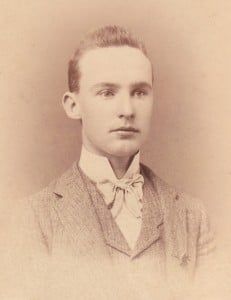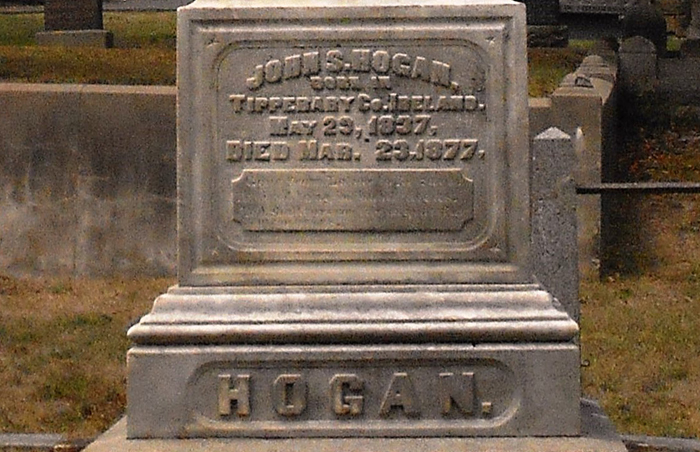Born in Tipperary County, Ireland on May 29, 1837, John S. Hogan immigrated to New Orleans in 1849 where some of his other relations already resided. New Orleans had a thriving Irish community at the time, and many lived in the neighborhood known as the Irish Channel. Hogan worked at the St. Charles Hotel on Canal Street for a time before setting off for California. The Panama Canal was not yet dug, so travelers made the overland portion of the trip on foot and by train. While on the long, dangerous journey he was shot in the head, but fortunately survived.
Once in California, Hogan, like most young men at the time, worked in the gold fields. He soon settled in Napa. By 1856 he was part of the founding committee of the Napa Reporter. He relocated to Healdsburg where he operated the Russian River Hotel and the Union Hotel, but after a fire burned much of the town in 1859 he sold off his shares of the Union and moved back to Napa. That same year he also married Ellen Barrett a fellow Irish immigrant who was living in San Francisco.
“[Hogan] purchased a restaurant on Main Street and opened for business in 1860. Hogan was a well-liked business man and his restaurant flourished to the extent that when David Wheelock, the owner of the Napa Hotel on the corner of First and Main decided to sell out, Hogan was ready to buy. He took possession of the hotel in 1862…During his life Hogan invested heavily in real estate. Like G. W. Crowey, Hogan held and rented out property all over Napa which, in addition to his other business interests, made him a wealthy man. He owned the entire block of Main Street bounded by First, Main, the Napa River, and Napa Creek.”[1]

John’s eldest son Henry followed his father into the hotel business after a brief stint as a cooper. He later became an attorney.[2] John passed away in 1877 at 39-years-old. His obituary noted his charity to the poor and his strong involvement in education. Less than a week before his death he was also honored as Chief Marshall at the Celebration of St. Patrick’s Day.
“Ellen Hogan must have been quite a formidable woman to be able to succeed and flourish in the world of business which, at this time was almost exclusively male dominated. It is know that Ellen Hogan loved show business people. Theatrical troupes and musicians passing through Napa on their way to the theatres of the Pacific Northwest would occasionally stay at the Napa Hotel and Hogan reportedly would listen for hours to stories of their travels and adventures. Ellen Hogan would become one of the primary forces behind the building of the Opera House.”[3]
The Hogans and Croweys have a long and tumultuous connection. Ellen Hogan and George Washington Crowey were involved in starting the Napa Opera House. Crowey’s son James got into an altercation with a his brother-in-law Peter Hogan (likely a younger relative of John’s) in 1872 that ended with James attempting to shoot Peter, missing only because a bystander knocked James’ aim. In the scuffle, part of James’ nose was cut off. The Sacramento Daily Union noted with a touch of sarcasm that “The splicing proved entirely ineffectual, and the unfortunate, if not originally possessed of a genuine ‘pug,’ can henceforth boast of one of no mean order.”[4]
[1] Aldrich, Richard. History of the Napa Opera House: 1879-2008. Presentation at Napa County Historical Society, March 2, 2008. Manuscript Collection, MS 548, 2008.185.1.
[2] Setty, Cecelia Elkington. Atlas Peak: A History of a Napa County Settler 1870-1902. 2004.
[3] Aldrich, 2008.
[4] “Napa County.” Sacramento Daily Union, September 23, 1872.
Cover image: findagrave.com


